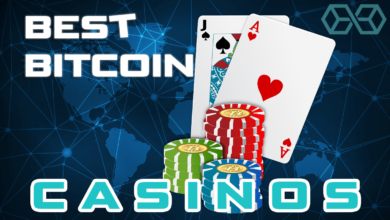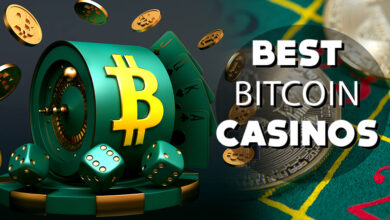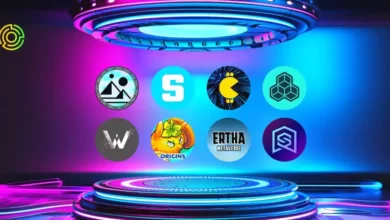Best Casino Games Online To Earn Real Money In December 2022

Casino games give players a chance to have fun while earning money online. And you can find a lot of them online. So it should be simple to find casino games to play. Finding the appropriate platforms, however, to play casino games is a challenge.
The greatest casino games allow you to gamble honestly and risk-free. You can also enjoy playing from the convenience of your house or workplace. As a result, you can go to something other than conventional casinos.
Unfortunately, choosing the best platform from the hundreds available online will require time and effort. That is why we attempted to compile a list of the top five online casinos. Top platforms on our list ensure the finest user experience while protecting you from fraud and unfair competition.
Top 5 Gambling Sites To Play Online Casino Games
- BitStarz – Overall Best Casino Games Online To Earn Real Money, Editor’s Pick
- Ignition Casino – Popular Platform For Online Gambling With Slot Machine Options
- mBit Casino – Highly Recommended Site For Video Poker & Casino Games
- BetOnline – Most Trusted Online Casino Table Games To Win Real Money
- Wild Casino – Best To Play Live Casino Video Poker Games Online
1. BitStarz – Overall Best Casino Games Online To Earn Real Money, Editor’s Pick
BitStarz started in 2014 and ushered in a new era of online casinos powered by cryptocurrencies. Before BitStarz entered the market, a few casinos took Bitcoin but were mainly insecure. BitStarz altered the game. And as of right now, it is the biggest cryptocurrency-friendly online casino.
On its website, Bitstarz receives hundreds of visitors every day. It features a massive selection of games that its many partners have created. Because the casino’s owners are avid gamers, they significantly invest in the client experience. Its customer service is likewise staffed with knowledgeable, exceptional people who go above and above to optimize enjoyment.
Classic games, including blackjack, craps, poker, and baccarat, are available at BitStarz Casino. These games are available at a variety of stakes and levels.
Bonuses: When playing on the BitStarz website, players can take advantage of various bonuses. When you register, you receive bonus spins. After signing up, you receive your first 25 spins for free, and you receive extra spins when you make your first deposit. You can win $500 worth of Bitcoin after your first four deposits. Additionally, new players can receive up to 180 free spins after completing their required deposits. They receive 20 bonus spins daily until they’ve used up all 180.
The website also provides VIP welcome incentives for consumers who desire to make many deposits at once. The lowest amount is 0.15 BTC, while the highest is 1 BTC. You receive 100 free spins and a 25% bonus on your first deposit with the VIP welcome offer.
Large Game Selection: BitStarz offers almost 3,500 games. It has become the most well-known cryptocurrency casino online as a result. And the casino continues to expand its selection of games. The business collaborates with some game developers who create excellent software. Microgaming, NetEnt, cooking Games, EGT, Nextgen, Play’nPlay’n GO, and BetSoft are some of its partners.
Multiple Payment Options: BitStarz is the biggest cryptocurrency-friendly online casino. It accepts some cryptocurrencies, including Ethereum, Litecoin, Dogecoin, Bitcoin Cash, and Bitcoin. However, it takes other payment methods besides bitcoins. Credit cards, bank transfers, and online payment options are all accepted.
The casino also offers instant payments. Additionally, there is no withdrawal cap. The number of withdrawals you can make per day or month is up to you.
Excellent User Interface: The user interface of the casino’scasino’s website is outstanding. From the home page, navigation is simple. The games are thoughtfully organized so you can scroll and see as many. Additionally responsive for a better user experience across many platforms, including the website.
Pros
Online cryptocurrency casino
Accepts traditional payments
Great user interface
A large number of games
Instant withdrawals
Unlimited daily transactions
Free spins and bonuses
Impressive customer service
Cons
Unavailable in the US and UK
2. Ignition Casino – Popular Platform For Online Gambling With Slot Machine Options
Ignition Casino came live in 2016 and has become a paradise for poker lovers. It is one of the most popular online poker casinos. One of the most popular online casinos in the US is Ignition Casino.
Due to the substantial traffic it receives, the casino hosts poker tournaments and other cash games. It contains more than 30 dealer games created to be as entertaining and lucrative as possible for you. With casino fans worldwide, you can play baccarat, roulette, blackjack, and many other games.
Since the Kahnawake Gaming Commission has granted the Ignition Casino a Canadian gaming license, playing there is permitted. Additionally, the casino is connected to well-known international brands like the PaiWangLuo network.
Amazing New-Player Bonus: After making their initial deposit, new gamers can receive incentives worth up to $2000. They also get access to Zone Poker, the frantic variation of the mobile game. They can also participate in the weekly tournament, where the prize pool is up to $2 million.
Ignition Casino customers can access various payment options, including conventional payment methods and cryptocurrencies, for deposits and withdrawals. The speed of the payment platform varies depending on the package you choose. Once you have enrolled, there are benefits for your first deposit.
Ignition Casino was initially a web-based service. However, players can now use their phones and tablets to access the platform. To increase player accessibility, the casino released its mobile application for iOS and Android smartphones. Unfortunately, there are few games available on the portable edition.
You get full access to the casino via the web version. You can check out the upcoming competitions and play in poker tournaments. The website also provides options besides poker.
Customer service is a priority for Ignition Casino, which receives a lot of traffic. Thus it’s a round-the-clock client service. The staff there is courteous and helpful. No matter the time or place, they are always willing to assist.
Pros
Fast-paced Zone Poker
Available on mobile
Multiple games available
Weekly tournaments
Bonus on first deposit
Anonymous tables
Cons
No free trials
Limited access to games on the mobile app
3. mBit Casino – Highly Recommended Site For Video Poker & Casino Games
Casino mBit started in 2014. This one is one of the best casinos that accept fiat money and cryptocurrencies. The casino is regarded as one of the most reliable ones online. Every player can win real money using the appropriate techniques since it ensures fair play.
The casino complies with all legal laws and has an exclusive license. More than 2,000 games are available. These consist of roulette, blackjack, table games, and slot machines.
Cashbacks and Bonuses: For new and returning players, mBit casino offers sizable bonuses and cash back. New players can receive a reward of up to 100% on their initial deposit. The maximum compensation is 100 USD and 1 BTC in cryptocurrency. Two hundred fifty free coins are also available to new gamers on the no-charge slot machines. You can also take pleasure in other fantastic winnings from the free slot games.
Additionally, mBit Casino offers Friday deposit bonuses to customers. Each week, members receive a 100% bonus on their Friday deposits. On other weekdays, they can receive rewards equal to 50% of their deposits. The casino also provides daily cash back on losses. Every member gets a 20% payback on their gaming losses.
Quick Deposit and Withdrawal: Use the casino platform to make deposits and withdrawals quickly. You won’twon’t have to wait days for your money because the processing is rapid. mBit Casino also has a high withdrawal cap of 100 BTC.
Multiple Platforms Accessible: The casino is online and has a responsive website. It functions flawlessly on all mobile devices, tablets, and computers. Applications for iOS and Android are also available for download. To enter the casino, you do not need to download the app—both the main version and the mobile version of the website run without a hitch.
Safe and Secure Platforms: The casino guarantees that your data and funds will be kept safe on an adequately guarded platform. The apps and website both employ 128-bit SSL encryption.
Pros
Regulated casino
Safelist
Accepts cryptocurrency
Safe and secure platform
Massive bonus
Cashback from losses
Cons
Unavailable in the US and UK
4. BetOnline – Most Trusted Online Casino Table Games To Win Real Money
One of the earliest brands of online poker is bet. The casino has been around since 1991, but in 2011 it switched to playing online poker. It has amassed significant experience, a devoted following, and thousands of favorable evaluations over the years.
When the website teamed up with connected games in 2016, its popularity increased. It has remained one of the top US online casinos ever since. Huge bonuses, challenging competitions, and challenges keep its members interested and draw in new ones daily.
Massive New-Player Bonuses: In the new player freeroll, new players can win up to $5000. Every Sunday, the company arranges weekly slots for new customers. To access the slot machines, you must purchase a ticket, and you may walk away with $5000.
Poker Tournaments: For its patrons, the casino hosts sizable tournaments. You can sign up for the competition and select the table based on your preferences. Before the game starts, the specifics of the rules and players will be revealed. When you join a table, you can also learn about guaranteed prizes. This website’swebsite’s poker events are fiercely competitive and draw top players from the US and other nations.
Website usability: The website is easy to use and navigate. For easier access, all the games are listed on the homepage. You may get further information on competitions, participants, games, and partners from the side menu. The website is also responsive and quick for a better user experience. The mobile app lets you access the games as well. This enables access to the casino from any device.
Outstanding Customer Support: BetOnline provides its customers with one of the most excellent customer support services. Customer care is offered around the clock to accommodate members from various nations. Despite the website’swebsite’s heavy traffic, the staff members are always eager to assist and address questions.
Pros
Exclusive poker software
Large-scale poker event
Freerolls for brand-new players
The US has a responsive website.
Cons
PayPal is not supported.
5. Wild Casino – Best To Play Live Casino Video Poker Games Online
In 2006, Wild Casino first opened. There are several top casino games and live dealer games available nowadays. The firm offers live casino table games and real money games. You can play games like baccarat, roulette, and blackjack. The website allows you to customize the match parameters to suit your preferences. As a result, you can play based on your interest and experience level.
The website also has an integrated banking system to facilitate withdrawals and deposits. Twenty different Fiat and cryptocurrency alternatives are available. MasterCard, Visa, American Express, MoneyGram, and bank transfers are all accepted on the website. The use of Bitcoin, Litecoin, Ethereum, Bitcoin Cash, Tether, and numerous other alternative currencies is also permitted.
Welcome Bonuses: Wild Casino provides a $5000 welcome bonus. Spread across five deposits is this bonus. Therefore, to receive all the benefits, you must make five deposits. Additionally, the maximum incentive is $9000. However, all perks end after 30 days.
Comfortable user interface: It is simple to use and browse the website. As you look for a game to play, you can browse the numerous categories. Moreover, it is quick and safe. To protect your information, it employs SSL technology.
Customer assistance is available at Wild Casino around the clock. You can get in touch with its helpful customer support representatives through email and the live chat feature on its website. The website also provides helpful information and advice to make it easier for you to use the platform.
Quick Payments: Wild Casino’sCasino’s integrated banking system streamlines payments. Due to the short processing time, there are no delays. Bitcoin and fiat money can both be used for deposits and withdrawals.
Pros
Numerous live dealer games
Customizable table limits
Integrated banking system
Accepts crypto and fiat currencies
24/7 support
Cons
No phone support
How We Made The List Of The Best Casino Games Online?
Finding the top casino games among the numerous online casinos is challenging. We spent some time researching the top titles to compile our list of the top casino games for 2022. We used our study to rate casino games by considering various variables.
Factors We Considered
Games: We started by considering the games available at each online casino. The casinos with the most outstanding selection of games were chosen. To assess the game’s quality, we also considered their creators. All of our top picks have games created by respected developers.
Reputation: Before ranking them, we evaluated the standing of numerous casino games. We picked online casinos with a good track record and plenty of knowledge. We can assess each company’scompany’s reputation using client comments and expert reviews.
Money: During our deliberations, we determined the minimum amount needed to play a game. Next, we looked at how simple it was to deposit and withdraw money. We have selected casino games that may play with fiat money and cryptocurrencies.
User Interface: For a better gaming experience, online casino games need a first-rate user interface. This is why we considered the design and interaction of the game’s games websites. To determine whether the website is mobile-friendly, we also examined its responsiveness.
Buying Guide: How To Select The Best Online Gambling Casino Games Platform?
Before selecting a platform to play games on, you must consider a few aspects if you are new to online casinos. Because there are so many online casinos, it is simple to be duped. You want to select a platform that gives the best experience and avoids scams. Therefore, please provide the following things some thought:
Available Casino Games
The casino games that are offered on a platform must be taken into account first. Popular games include poker, roulette, and blackjack. However, specific legal limitations can prevent you from using or accessing them. Therefore, you must locate a platform that provides the games you desire. You can also look at websites that offer a wide range of possibilities.
Funding & Withdrawal
These two concepts are the main features. If you’re looking for real-money online casino games, it might be beneficial to research them. You should be able to fund your account on a website to play games. It would be preferable if you also considered the terms of withdrawal. The finest casinos allow both fiat cash and cryptocurrencies. They also expedite the processing of your deposits and withdrawals.
Bonuses & Cashbacks
The greatest online casino games provide bonuses when you sign up and make a deposit. When you lose games, some even let you receive a portion of your money back. Therefore, it is best to compare existing promises before selecting casino game platforms.
Customer Feedback
Choose a website for casino games after taking client reviews into account. Every platform will make an effort to promote itself. Customer reviews, however, might assess the experience they provide. So if you want to understand more about the casino games you wish to play, check out trustworthy consumer review sites like Trustpilot.
FAQs On Online Casino Games
Which online casino game platforms are the best for poker?
The most excellent websites for playing poker are those in our review. Poker and other online casino games are best played on BitStarz. Ignition Casino is another option and is the most prominent poker platform available. Due to a large number of users on the Internet, you can participate in tournaments and win a lot of money.
Is it legal to play casino games in the US?
In the majority of US states, gambling online is prohibited. There might be a few games you can play, though. However, one of them is not poker. Only Nevada, Delaware, New Jersey, Pennsylvania, West Virginia, and Michigan permit casino games.
But specific platforms have made it possible for Americans to play casino games without running the danger of being charged. You can use cryptocurrencies or alternative payment options to fund your gaming wallets.
Can I play casino games for free?
The majority of casino games are played to win money. Therefore, it would be unlikely to locate any casino games for free. Most websites only provide bonuses once you have fulfilled specific financial commitments, such as an initial deposit. Therefore, you may only access free slot games after making a deposit. You can practice on several other websites by playing free games. That, however, would not qualify as gambling. As a result, you won’t win anything from them.
Concluding About The Top 5 Casino & Gambling Sites
Five online casinos that let you play and win big are featured in our assessment of the finest casino games. To create this list, we carefully evaluated some variables. BitStarz, Ignition Casino, mBit Casino, BetOnline, and Wild Casino are some of our top recommendations.
These platforms have several elements in common. A few examples are casino games, a solid track record, expertise, top-notch customer service, and user-friendly websites. Both fiat money and cryptocurrencies are accepted.
However, BitStarz is the finest option. Simply put, it stands out from the crowd. The online casino tops the list with more than 3,500 games to choose from and significant user bonuses. Numerous cryptocurrencies, as well as more conventional payment options, are accepted. Additionally, it offers customers daily free spins.
For your casino games, we advise BitStarz and the other platforms on our list. But to aid you in selecting the finest venue, we have included shopping guidance in our study. In general, you can play both video and traditional slots.




